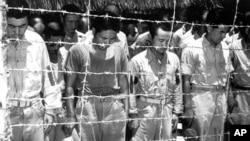On Friday, Japan commemorated the 69th anniversary of Emperor Hirohito’s announcement of impending surrender to the Allies, bringing to an end the most destructive war in history.
Two Japanese cabinet ministers and 80 politicians marked the occasion by visiting the controversial Yasukuni Shrine, which commemorates the country’s war dead. Japan lost approximately three million people in the conflict.
The government’s visit, which included a symbolic offering sent by Japanese Prime Minister Shinzo Abe, was condemned by China and South Korea, who believe the shrine celebrates Japan’s wartime aggression. Among those commemorated in the shrine are 14 convicted war criminals.
Tokyo’s surrender in World War II was a momentous event for Japan. And the circumstances surrounding the war’s conclusion continue to impact the region today, according to two prominent historians, Rana Mitter and Mark Selden.
Selden, author and senior research associate in the East Asia Program at Cornell University, said Emperor Hirohito’s speech had a dramatic impact on the Japanese people.
“They heard the emperor for the first time on the radio, he had never spoken to the Japanese people before,” he said. “And he spoke in a kind of stilted, distant archaic language that was crafted for him, but he gave the message of surrender.”
During the previous week, the United States dropped atomic bombs on the Japanese cities of Hiroshima and Nagasaki killing hundreds of thousands of people. In addition, the Soviet Union had declared war on Japan, and invaded Manchuria.
Both Japan and China were devastated by the long-running war. In Japan, the country had withstood both the atomic bombings as well as the firebombing of more than 60 Japanese cities. Selden described it as the “utter destruction of virtually the entire urban landscape of Japan.”
In China, the situation was parallel to that of Japan’s, according to Mitter, Oxford University professor and the author of Forgotten Ally: China’s War with Japan 1937-1945. “It’s often forgotten in the west, but China was the first Allied country to enter what we call World War Two,” he said.
China’s Nationalists, the recognized government of China under Chiang Kai-shek, and the Communists under Mao Zedong, fought Japanese forces after Tokyo invaded China in 1937. By August 1945, China was at a breaking point, according to Mitter.
“China was devastated by horrifying price inflation, so people were literally almost carrying wheelbarrows full of banknotes to pay for their bills because the value of money had been essentially sucked away,” he said. “And also the Japanese invasion had caused a huge number of atrocities in China; some of the most famous in the early years of the war include the notorious Rape of Nanking.”
According to Mitter, China’s armies were exhausted, many of the soldiers were starving and the government was corrupt. But he said the Chinese forces accomplished an important goal: they diverted a substantial number of Japanese troops from the Pacific theater, and delayed Japanese intentions against the Soviet Union and India.
“Therefore the fate of Asia as a whole, and the fate of the Japanese Empire, would have been different for a whole variety of reasons,” he said.
For his part, Selden believes the Soviet Union’s declaration of war against Japan and subsequent invasion of Manchuria factored prominently in Tokyo’s surrender. During the wartime conferences in Yalta and Potsdam, Moscow agreed to declare war against Japan once Nazi Germany had surrendered. Selden believes the Soviet Union’s involvement in the final Allied push against Japan, even more than the American atomic bombing of the two Japanese cities, spurred Tokyo to capitulate.
“In my view we can only understand the end of the war by putting those two events together, and in my own assessment of them, the Soviet entry is probably the more important one, given the fact that Hirohito and his advisers, and the Japanese military, had been more or less unmoved by the destruction of Japan’s cities in the preceding six months,” he said.
Mitter believes the lack of a wartime conference in Asia such as those at Yalta and Potsdam has led to many of the current regional tensions involving territorial disputes and historical perceptions.
Could those current tensions push China and Japan into a new military confrontation, as some observers have suggested?
Mitter believes it is unlikely. “Relations today between China and Japan are bad, but as someone who has of course written a book about a real war breaking out between China and Japan in the 1930’s, they’re nothing like as bad as that period,” he said.
Selden said China and Japan’s differing views on the war contribute to the current tensions.
“Not only do we have an inability of Japan to put behind its record of conquests, empire and war atrocities, we have a continued insistence by Japanese leaders to reify the war, by visits to Yasukuni Shrine, by denial of the Nanjing incident, by denial of the comfort women atrocities, and so forth,” he said.
Mitter believes the Chinese media’s inaccurate portrayal of widespread support among the Japanese for the official visits to the Yasukuni Shrine heightens the bilateral tensions. In fact, he says many Japanese academics, teachers and journalists publicly acknowledge and regret the country’s responsibility for the atrocities.
“Until the two sides have a genuine understanding of how each other sees the question, I think it’s going to be very hard to resolve the often rather distorted historical basis on which these present day political claims are being made,” Mitter said.











